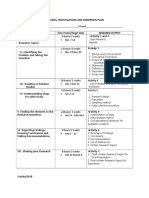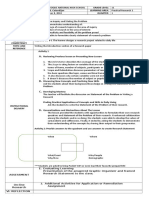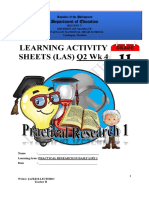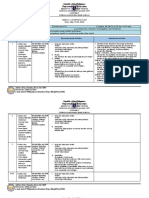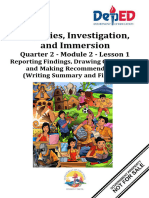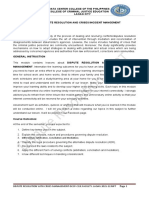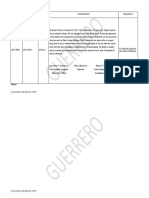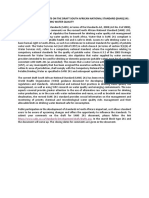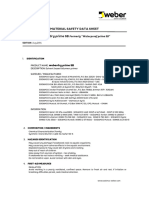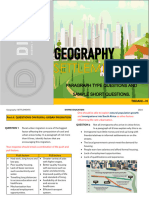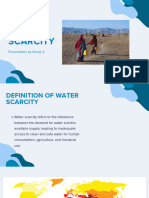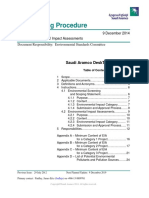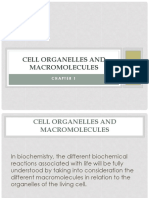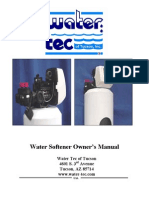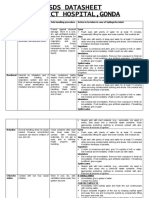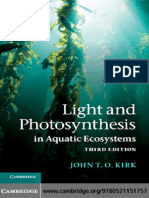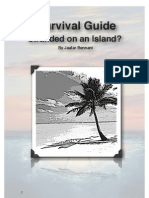Practical Research 1 Q2W7
Practical Research 1 Q2W7
Uploaded by
VERDADERO LevisthoneCopyright:
Available Formats
Practical Research 1 Q2W7
Practical Research 1 Q2W7
Uploaded by
VERDADERO LevisthoneCopyright
Available Formats
Share this document
Did you find this document useful?
Is this content inappropriate?
Copyright:
Available Formats
Practical Research 1 Q2W7
Practical Research 1 Q2W7
Uploaded by
VERDADERO LevisthoneCopyright:
Available Formats
WHOLE BRAIN LEARNING SYSTEM
OUTCOME-BASED EDUCATION
PRACTICAL
PRACTICAL RESEARCH
RESEARCH 1 1 GRADE
(QUALITATIVE RESEARCH)
(QUALITATIVE RESEARCH) 12
QUARTER 2
LEARNING
MODULE WEEK 7
WBLS-OBE MELC-Aligned Self-Learning Module Practical Research 1 0
MODULE IN
PRACTICAL RESEARCH 1
(QUALITATIVE RESEARCH)
QUARTER 2
WEEK 7
DRAWING CONCLUSIONS FROM PATTERNS AND
THEMES AND FORMULATING RECOMMENDATIONS
BASED ON CONCLUSIONS
Development Teams
Writers: Teresa A. Cudal Marjorie D. Nolasco
Rei Karlo Ramos Allan Alonzo
Mark Bulong
Editors: Maria Corazon H. Retutal Richard A. Hapa
Reviewers: Adelyn C. Domingo
Illustrator: Wynnelord Rainier E. Tibay
Lay-out Artist: Wynnelord Rainier E. Tibay
Management Team: Vilma D. Eda Arnel S. Bandiola
Lourdes B. Arucan Juanito V. Labao
Adelyn C. Domingo
WBLS-OBE MELC-Aligned Self-Learning Module Practical Research 1 1
Writing a conclusion and recommendation for your research paper can be challenging.
However, as you complete the given lessons and different activities provided in this module,
you are expected to be able to:
Most Essential Learning Competencies:
1. draw conclusions from patterns and themes (CS_RS11IVg-j-1);
2. formulate recommendations based on conclusions (CS_RS11IVg-j-2).
Pre-Test
A. Read each statement below carefully. Write TRUE if you think the statement is correct and
write FALSE if the statement is wrong. Write your answer on a sheet of paper.
1. A good conclusion chapter should discuss the researcher’s own assumptions and
ideas about the topic under study
2. Research implications presented in a study must be either theoretical only or
practical only.
3. Conclusions are the general statements which provides answers to the research
problem.
4. A good recommendation should be broad, generic and are not directly related to
the topic of the research
5. If some of the research questions were not answered or some research objectives
could not be achieved, then the final report must explain and reflect on the reasons
why this is the case.
WBLS-OBE MELC-Aligned Self-Learning Module Practical Research 1 2
Lesson DRAWING CONCLUSIONS
1 FROM PATTERNS AND
THEMES
As you have learned from previous lessons, qualitative researchers usually use
multiple forms of data including interviews, observations, and documents. For such data to be
analyzable, they must first be grouped into meaningful patterns and/or themes to facilitate
drawing of conclusions. This module will serve as your guide in writing effective and
reasonable conclusions.
In the previous lessons, you have learned how to infer and explain patterns and
themes based on the data you gathered through observations. In this activity, you are going
to try to draw conclusions from patterns and themes.
Direction: Look at the picture on the left carefully, then answer the questions on the right.
Remember to form credible conclusions based on your observations. Write your answers on
a separate sheet of paper.
Draw a Conclusion: Visual
Details
1. What are these people doing?
___________________________
___________________________
__________________________.
2. Give three details from the
picture supporting your
answer/conclusion.
___________________________
PHOTO: AGENCE FRANCE-PRESSE ___________________________
https://www.straitstimes.com/asia/se-asia/cleaning-up-manila-bays-
cesspool ___________________________
(Adapted with revisions from: Shirley A. Magayanes. https://lrmds.deped.gov.ph/detail/17924)
WBLS-OBE MELC-Aligned Self-Learning Module Practical Research 1 3
Direction: Read the following story and answer the questions that follow. Write your
answer on a separate sheet of paper.
After playing a couple of online games in an internet café, Joshua rushes to his
bedroom and immediately turns on the light as the clock chimed eight times. He knew it
would soon be bedtime, so he hurries to find his module to work on. It is nearing the end
of the week and yet he had not even started reading anything yet. He knew his teacher
would be disappointed in him if he did not submit his answer sheets on time.
1. The story takes place:
A. in the morning B. at night
Why do you think that? _________________________________________________
2. The story takes place in:
A. modern times B. ancient times
Why do you think that? _________________________________________________
The above activity is only to test your ability to make simple conclusions based on
information learned from a text. In the next lessons, you will learn how to make concluding
statements that would remind the readers of your research paper of the strength and impact
of your argument and help them refocus their attention to the most important points of your
paper.
Now that you are done analyzing the data you have gathered in your research work,
the next step is to draw conclusions. These conclusions should arise from the factual data you
encountered and analyzed when you conducted the research. Further, any conclusions drawn
or deduced by you from facts or statements resulting from logical thinking rather than from
another assumption, prediction, or generalization are the only ones included in the conclusion
section of your research paper (Baraceros, 2016).
WBLS-OBE MELC-Aligned Self-Learning Module Practical Research 1 4
Take note that the conclusion is intended to help the reader understand why your
research should matter to them after they have finished reading the paper. It is not merely a
summary of the main topics covered or a re-statement of your research problem, but a
synthesis of key points. Conclusions can also serve as a basis for continuing research,
creating new ideas to resolve an issue you highlighted in your paper or offering new
approaches to a topic. When writing your conclusion, you can consider the following
steps to help you get started:
1. Restate your research topic
Your first step when writing your conclusion should be to restate your research topic.
Typically, one sentence can be enough to restate the topic clearly, and you will want to
explain why your topic is important. This part of your conclusion should be clear and
concise and state only the most important information. Here is an example:
"The increase in water pollution since 2010 has contributed to the decrease in
aquatic wildlife as well as the increase in unsafe drinking water."
2. Restate the thesis
Next, restate the thesis of your research paper. The thesis statement refers to your
paper’s main point, main idea, or main message. You can do this by revising your original
thesis that you presented in the introduction of your paper. The thesis statement in your
conclusion should be worded differently than what you wrote in your introduction. This
element can also be effectively written in one sentence. Here is an example:
"Clean water is imperative to maintaining ecological balance and protecting the
public's health."
3. Summarize the main points of your research
Next, you can sum up the main points of your research paper. It is helpful to read
through your paper a second time to pick out only the most relevant facts and arguments.
You shouldn't need to include any more information than the main arguments or facts that
you presented in your paper. The purpose of summarizing the key points is to remind the
reader of the importance of the research topic. Here is an example to help illustrate how
to do this:
"With the increase in sugar farming, more and more pollutants are entering our
freshwater supplies. This increase in pollution has contributed to massive
decreases in marine life, fish die-off, increased respiratory illness in
neighborhood populations and has contributed to the shortage of clean drinking
water."
4. Connect the significance or results of the main points
After discussing the main points of your argument, you can present the significance of
these points. For instance, after stating the main points you made in your argument, you
WBLS-OBE MELC-Aligned Self-Learning Module Practical Research 1 5
might discuss how the impacts of your topic affect a specific outcome. Likewise, you might
present the results of studies or other findings that can help add emphasis to how you
present the significance of your information. Here is an example:
"Ecologists and marine biologists are continuing to measure the water quality,
and researchers are continuing to find ways to combat the pollution run-off from
commercial farms. In the future, the EPA hopes this research will lead to a
decrease in the pollutant concentration in our freshwater systems."
5. Conclude your thoughts
As you finish up your conclusion, you might create a call to action or pose an idea that
gets your readers thinking further about your argument. You might also use this sentence
to address any questions that were left unanswered in the body paragraphs of your paper.
Here is an example:
"If we cannot combat the ill effects that commercial farming has on our clean
water, our freshwater ecosystems and drinking water supplies will surely
diminish. More research and innovation are needed to maintain our clean water
while still supporting the agricultural needs of our economy."
(Adapted from: “How to Write a Conclusion for a Research Paper.” n.d. Indeed Career Guide.
https://www.indeed.com/career-advice/career-development/how-to-write-a-conclusion-for-a-
research-paper.)
Elaborating Learned Concepts. Check the column with the heading that expresses
your judgment about the following purported evidence to prove a conclusion.
Evidence Good Poor Reasons, Comments,
Evidence Evidence Reactions
1.The workers seem willing to
file labor case.
2.They worked hard the way
the characters in the movie,
The Bible, did their jobs.
3.The company’s records
show the number of absences
the laborers incurred.
4.Apparently, the laborers
failed to get their 13th month
pay last year.
5.For returning the lost and
found wallet containing
P15,000, the laborer received
a certificate of merit.
(Adapted from Baraceros, E.L. (2016). Practical Research 1. Rex Book Store, Inc.: Sampaloc, Manila)
WBLS-OBE MELC-Aligned Self-Learning Module Practical Research 1 6
Lesson FORMULATING
RECOMMENDATIONS BASED
2 ON CONCLUSIONS
Now that you know how to write conclusions based on patterns and themes of your
study, you can now start making recommendations. A recommendation in research
proposes a solution to a problem or evaluates possible solutions and recommends one.
Further, it may also provide practical suggestions for future research in similar fields.
After crafting your research conclusion, the next step for you to take is to write your
research recommendations. But before we proceed further, let us have a practice.
Formulate a simple recommendation based on the answer you made in the previous
“What’s In” activity using the guide questions on the left. Write your answers on a separate
sheet of paper.
Formulate a Recommendation
based on Conclusion
1. What are these people doing?
___________________________
__________________________.
2. Provide a recommendation for
them to be able to work more
efficiently.
___________________________
___________________________
PHOTO: AGENCE FRANCE-PRESSE
https://www.straitstimes.com/asia/se-asia/cleaning-up-manila-bays-
cesspool
(Adapted with revisions from: Shirley A. Magayanes. https://lrmds.deped.gov.ph/detail/17924)
WBLS-OBE MELC-Aligned Self-Learning Module Practical Research 1 7
Recommendations will be the last part of your Chapter 5. Recommendation is
commonly known as the section where you can give suggestions on the matters relative to
your research that must be improved. When writing, you must take the following
considerations:
• Recommendations must be brief. When writing your recommendations, take note
to write it concisely and as brief as possible.
• Recommendations should be clear. You must state the specific suggestions that
you want to imply in you study.
• Recommendations must be precise. When giving suggestions, you should avoid
vague recommendations to secure sufficient results
As recommendations should be crafted briefly, clearly, and precisely, here are some
guidelines by Prieto et al. (2017) that you can use when writing your own recommendations,
• You must avoid writing broad and generic recommendations. Also, avoid
recommendations that are not directly related to the topic of the research.
• Remember that recommendations are one step further than the conclusion.
• You must take into consideration that recommendations must be specified according
to the areas of concern (i.e., academe, policymakers, etc.).
As stated, recommendations should be expressed in clear and concise terms. They
should directly respond to key results of your study and are feasible for implementation.
Moreover, you may state what should be done, enumerate the steps needed to implement
your policy recommendation, and specify the needed resources, if any. Wherever it is
applicable, you may acknowledge limitations and make recommendations for future work as
well.
The following are sample recommendations adapted from Cristobal Jr., A.P. and M.C.
Cristobal. (2017):
Sample Recommendation 1:
Competencies and Performance Appraisal: Bases for the Development
of Kapampangan Principal’s Leadership Framework (Canlas, 2013)
WBLS-OBE MELC-Aligned Self-Learning Module Practical Research 1 8
Since this study is limited to a specific context and sampled a small number of
principals, it is recommended that a similar study be conducted in different contexts
that would explore and elaborate the role of culture in managing successful schools. It
is also recommended that a research-based, competency-linked, and a 360-degree
evaluation or triangulation process for Kapampangan principals be developed for
evaluation of performance and basis in changing of high-quality professional learning
programs.
Sample Recommendation 2:
The Level of Performance of Instructors: Basis for the Formulation of an
Academic Intervention Program (Cristobal, 2015)
With the abovementioned conclusion, an academic program to further develop the
performance of instructors in the different departments of the Saint Paul School of
Business and Law is hereby recommended.
Directions: For this activity, you will need the sources that you have used in the past
modules/lessons. To do this activity, you need to read and analyze the contents of the
recommendations of at least two (2) identified research papers. Fill in the needed information
in the following table. Write your answer on a separate sheet of paper.
Author and Date
Published Summary of the Research
Research Title
(Include website if source Recommendation
is from the internet)
ACTIVITY: Read the abstract below.
Abstract
The paper presents the most comprehensive and large-scale study to date on how
students perceive the impacts of the COVID-19 crisis on various aspects of their lives
on a global level. With a sample of 30,383 students from 62 countries, the study reveals
that amid the worldwide lockdown and transition to online learning students were most
satisfied with the support provided by teaching staff and their universities’ public
relations. Still, deficient computer skills and the perception of a higher workload
prevented them from perceiving their own improved performance in the new teaching
environment. Students were mainly concerned about issues to do with their future
professional career and studies, and experienced boredom, anxiety and frustration.
The pandemic has led to the adoption of particular hygienic behaviours (e.g. wearing
WBLS-OBE MELC-Aligned Self-Learning Module Practical Research 1 9
masks, washing hands) and discouraged certain daily practices (e.g. leaving home,
shaking hands). Students were also more satisfied with the role played by hospitals
and universities during the epidemic compared to the government and banks. The
findings also show that students with selected socio-demographic characteristics
(male, part-time, first level, applied sciences, lower living standard, from Africa or Asia)
were generally more strongly affected by the pandemic since they were significantly
less satisfied with their academic work/life. Key factors influencing students'
satisfaction with the role of their university are also identified. Policymakers and higher
education institutions around the world may benefit from these findings while
formulating policy recommendations and strategies to support students during this and
any future pandemics.
(Adapted from: Aristovnik, A.; Keržič, D.; Ravšelj, D.; Tomaževič, N.; Umek, L. Impacts
of the COVID-19 Pandemic on Life of Higher Education Students: A Global
Perspective. Sustainability 2020, 12, 8438)
Based on the above article, provide the required information below. Write your answer
on a separate sheet of paper.
1. Summary of Findings:
A. Objective of the study: ___________________________________________
B. Nature and size of the sample: _____________________________________
C. Locale of the study: _____________________________________________
D. Main problem: __________________________________________________
2. Conclusions: _________________________________________________________
___________________________________________________________________
3. Recommendations: ____________________________________________________
___________________________________________________________________
ACTIVITY: Learners will draw recommendations based on the given sample conclusion.
PERFORMANCE STANDARD:
The learner is able to make recommendations based on conclusions.
SITUATION:
The challenge involves dealing with critiquing an example of a recommendation from
previously conducted research study based on the guidelines that were discussed in
class.
SAMPLE CONCLUSION:
WBLS-OBE MELC-Aligned Self-Learning Module Practical Research 1 10
The study establishes that the Coronavirus pandemic has adverse effects on
education. COVID-19 has major effects on school characteristics, including
research, academic programs, Staff professional development and
jobs in the academic sector etc. These effects were felt by both educational
institutions, educators, students and parents and other stakeholders in education. The
study emphasizes the need for adoption of technology in education,
as a way to curb the effects of Coronavirus and other future pandemics in education.
Thus, the study acknowledges that the decision to shutdown schools for Coronavirus
across the world may be hurtful, but it is sensible considering the rate of spread, and
the dangers imposed by COVID-19 pandemic. The unprecedented school closures
for Coronavirus remains a lesson and a warning to the entire educational world
particularly those who are yet to embrace or adopt emerging learning technologies
that support online or remote education. Stakeholders in the education sector have to
develop robust strategies to deal with post-Coronavirus era.
The study establishes that the Coronavirus pandemic has adverse effects on education.
COVID-19 has major effects on school characteristics, including research, academic
programs, Staff professional development and jobs in the academic sector etc. These
effects were felt by both educational institutions, educators, students and parents and
other stakeholders in education. The study emphasizes the need for adoption of
technology in education, as a way to curb the effects of Coronavirus and other future
pandemics in education. Thus, the study acknowledges that the decision to shut down
schools for Coronavirus across the world may be hurtful, but it is sensible considering the
rate of spread, and the dangers imposed by COVID-19 pandemic. The unprecedented
school closures for Coronavirus remains a lesson and a warning to the entire educational
world particularly those who are yet to embrace or adopt emerging learning technologies
that support online or remote education. Stakeholders in the education sector have to
develop robust strategies to deal with post-Coronavirus era.
(Adapted from: Impact of Coronavirus Pandemic on Education, Onyema, E. et al., 2020,
Journal or Education and Practice
GOAL: Your task is to discuss the points raised in your critique and make your own
version of this recommendation.
ROLE: You are a researcher.
PRODUCT: You will create your own version of this recommendation in order to apply
the guidelines discussed.
AUDIENCE: You need to convince your research teacher that you able to apply the
guidelines in critiquing the given recommendation and coming up with your own version
of the recommendation.
STANDARDS: Your work will be judged by organization, clarity and accuracy, content
and message as provided in the performance task analytic rubric (see attachment)
PERFORMANCE TASK ANALYTIC RUBRIC:
OUTSTANDING SATISFACTORY DEVELOPING BEGINNING Rating
Criteria
4 3 2 1
Ideas for moving Ideas for moving Ideas for moving Ideas for moving
students forward students forward students forward students forward
Organization
address all issues address all address some, are not
and are complete issues and are but not most addressed.
WBLS-OBE MELC-Aligned Self-Learning Module Practical Research 1 11
as well as complete as well issues, or are not
thorough. as thorough. particularly
relevant or
pedagogically
useful
Your techniques Your techniques Your techniques Your techniques
and approaches to and approaches and approaches and approaches
addressing to addressing are adequately are not properly
student issues are student issues described. described.
fully described, are fully
with example described, with Recommendation Recommendation
Clarity and ideas and steps example ideas s are somewhat s are not
Accuracy given. and steps given. enhanced with enhanced with
relevant relevant
Recommendations Recommendation references or references or
are enhanced with s are enhanced resources. resources.
very relevant with relevant
references or references or
resources. resources.
Recommendations Recommendation Recommendation Recommendation
are pedagogically s are s are somewhat s are not
appropriate and pedagogically pedagogically pedagogically
follow ideas given appropriate and appropriate and appropriate and
in course follow ideas given follow ideas given follow ideas given
Content, materials in course in course in course
Mechanics materials materials materials
and Message Well written, and
free from Well written, and Well written, and Not particularly
grammatical and free from free from well written (hard
spelling errors. grammatical and grammatical and to follow, spelling,
spelling errors. spelling errors. or grammar
errors).
Total
Reference: https://people.wou.edu/~fleschb/Math611/EvaluationRecommendationRubric.pdf
Directions: Choose the letter of the correct answer from the choices given and write the
letter of your choice on a separate sheet of paper.
1. Which part in a research paper that emphasizes the opportunity to write suggestions for
the improvement of the research study?
A. Conclusion B. Recommendations C. References D. Summary
2. Which one is NOT the purpose of the research conclusion?
A. It should establish good organization.
B. It does not leave a conclusive impression to the readers.
C. It provides the written output a sense of completeness
D. It stresses the importance of the research statement.
WBLS-OBE MELC-Aligned Self-Learning Module Practical Research 1 12
3. What is the basis for drawing conclusions in qualitative research?
A. From statistical findings
B. From demographic data
C. From patterns and themes
D. All of the choices are correct
4. Recommendations should be based on?
A. Conclusions B. Findings C. Objectives D. Reference
5. When writing the recommendation, all of the following should be taken into consideration
except—
A. It must be brief.
B. It should be clear
C. It should be broad.
D. It should be precise.
Aristovnik, Aleksander, et al. “Impacts of the COVID-19 Pandemic on Life of Higher Education
Students: A Global Perspective.” Sustainability, vol. 12, no. 20, 1 Jan. 2020, p. 8438
AUT Library.(2020). APA 6th Referencing Style Guide. https://aut.ac.nz.libguides.com/
Baraceros, E.L. (2016). Practical Research 1. Rex Book Store, Inc.: Sampaloc, Manila
Bernardez, E.B. (2011). Methodology of Research and Thesis Writing. Jimczyville
Publications: Tinajeros, Malabon City.
“Cleaning up Manila Bay’s ‘Cesspool.’” The Straits Times, 22 Dec. 2018,
www.straitstimes.com/ e-asia/
Cristobal Jr., A.P. and M.C. Cristobal. (2017). Practical Research 1. C&E Publishing, Inc.:
South Triangle, Quezon City
“How to Write a Conclusion for a Research Paper.” n.d. Indeed Career Guide.
https://www.indeed.com/career-advice/career-development/how-to-write-a-
conclusion-for-a-research-paper.
WBLS-OBE MELC-Aligned Self-Learning Module Practical Research 1 13
Faltado III, R.E. et al.(2016). Practical Research 1. Lorimar Publishing Inc.: Cubao, Quezon
City, Metro Manila.
Lutfiani, Dian, (2018). The Use of Gadget on Students’ Study Habit in English Language
learning at Sma An-najiyah Surabaya.
http://digilib.uinsby.ac.id/28760/1/Dian%20Lutfiani_NIM%20D75213054.pdf
Marquez- Fong, E.E., &Tigno, C. (2016). Practical Research 1, Qualitative. Quezon City,
Metro Manila. Vibal Group Inc.
Newton Gresham Library.(2021, January 11). Bibliography or List of References.
https://shsulibraryguides.org/thesisguide/references
Onyema, E. et al. (2020). Impact of Coronavirus Pandemic on Education, Journal or Education
and
Practicehttps://www.researchgate.net/publication/341787426_Impact_of_Coronaviru
s_Pandemic_on_Education
Prieto N.G., et al. (2017). Practical Research 1. Lorimar Publishing Inc.: Quezon CityMetro
Manila.
Shirley A. Magayanes. https://lrmds.deped.gov.ph/detail/17924
The University of Queensland Australia.(n.d).UQ Harvard referencing style.
https://guides.library.uq.edu.au/referencing/uqharvard/reference-list
4. A 2. B 2. FALSE 4. FALSE
Answers may vary
5. C 3. D 1. B 5. TRUE 1. FALSE 3. TRUE
What I Can Do/ What’s In
Assessment What I Know What’s New/ What’s More /
WBLS-OBE MELC-Aligned Self-Learning Module Practical Research 1 14
For inquiries or feedback, please write or call:
Department of Education-Schools Division of Laoag City
Curriculum Implementation Division (CID)
Brgy. 23 San Matias, Laoag City 2900
Contact Number: (077)771-3678
Email Address: laoagcity@deped.gov.ph
You might also like
- Chapter 22 - Water and Wastewater Treatment Plant HydraulicsDocument90 pagesChapter 22 - Water and Wastewater Treatment Plant HydraulicsNguyen Phuc Pham100% (5)
- Coffee Brewing - Wetting, Hydrolysis & Extraction RevisitedDocument8 pagesCoffee Brewing - Wetting, Hydrolysis & Extraction RevisitedUmut GökdenizNo ratings yet
- LP Inquiry Week1.2 Checked 2 18 23Document4 pagesLP Inquiry Week1.2 Checked 2 18 23Ria Sumampong100% (1)
- Cdi 8: Technical English 2 Legal Forms SY 2021-2022Document10 pagesCdi 8: Technical English 2 Legal Forms SY 2021-2022VERDADERO Levisthone100% (1)
- I.I.I. 3rd and 4th Q ModuleDocument53 pagesI.I.I. 3rd and 4th Q ModuleAruel DelimNo ratings yet
- Department of Education: Learning Activity Sheets in Practical Research 1Document12 pagesDepartment of Education: Learning Activity Sheets in Practical Research 1Miyu VianaNo ratings yet
- Department of Education: Republic of The PhilippinesDocument24 pagesDepartment of Education: Republic of The PhilippinesJomarie LagosNo ratings yet
- Practical Research 2 Describe The Characteristics Strengths Weaknesses and Kinds of Quantitative Research MELC 1 LASDocument15 pagesPractical Research 2 Describe The Characteristics Strengths Weaknesses and Kinds of Quantitative Research MELC 1 LASJoana Taruc0% (1)
- PR2 ActivityDocument1 pagePR2 ActivityCherieJavilinarFandialanNo ratings yet
- Fig. 1. The Code and Theme of The Possible ObservationDocument3 pagesFig. 1. The Code and Theme of The Possible ObservationYenyen Quirog-Palmes100% (1)
- Lesson Plan in Pr1Document5 pagesLesson Plan in Pr1Lotis Abenis - RompalNo ratings yet
- 2SHS-Module-PR 1-Practical ResearchDocument22 pages2SHS-Module-PR 1-Practical ResearchLanieRasimoNo ratings yet
- PR LP 4 2023Document21 pagesPR LP 4 2023juliuscesar1112No ratings yet
- Las 1 PR1Document14 pagesLas 1 PR1Lannie YeonNo ratings yet
- Practical ResearchDocument8 pagesPractical ResearchLouisseNo ratings yet
- Practical Research 2: Department of EducationDocument9 pagesPractical Research 2: Department of EducationLianne LagayanNo ratings yet
- Learning Area Grade Level Quarter Date I. Lesson Title Ii. Most Essential Learning Competencies (Melcs) Iii. Content/Core ContentDocument4 pagesLearning Area Grade Level Quarter Date I. Lesson Title Ii. Most Essential Learning Competencies (Melcs) Iii. Content/Core ContentAlvin PaboresNo ratings yet
- Activity Sheets PR 2 Week 1Document7 pagesActivity Sheets PR 2 Week 1Troy Dacumos100% (1)
- Inquiries, Investigations and Immersion: Activity 3Document1 pageInquiries, Investigations and Immersion: Activity 3cherry onaNo ratings yet
- Las3 q1 Pr2 September 24 2021 Submission DateDocument8 pagesLas3 q1 Pr2 September 24 2021 Submission DateKaye PenazoNo ratings yet
- LAS in PRACTICAL RESEARCH 1 QUARTER 3 WEEK 3-4Document10 pagesLAS in PRACTICAL RESEARCH 1 QUARTER 3 WEEK 3-4Aldrin Dela CruzNo ratings yet
- Practical Research 2: Department of EducationDocument7 pagesPractical Research 2: Department of EducationLianne LagayanNo ratings yet
- Banzon 2. Mijeno 3. Gomez 4. Villaruz 5. Zara: Department of EducationDocument2 pagesBanzon 2. Mijeno 3. Gomez 4. Villaruz 5. Zara: Department of EducationJocet GeneralaoNo ratings yet
- Practical Research Module 1 3 Melvin R. Meneses 12 STEM SystematicDocument29 pagesPractical Research Module 1 3 Melvin R. Meneses 12 STEM SystematicJasmine CorpuzNo ratings yet
- 3statement of The ProblemDocument2 pages3statement of The ProblemJean CatandijanNo ratings yet
- Practical Research 2: Quarter 1: Module 1-4Document31 pagesPractical Research 2: Quarter 1: Module 1-4Kayzelle RefamonteNo ratings yet
- STEM PR2 Osorio Week-5-6Document19 pagesSTEM PR2 Osorio Week-5-6ganda dyosaNo ratings yet
- Module Prac 1Document19 pagesModule Prac 1Dexter FernandezNo ratings yet
- Adm-Shs-Raws-Lesson 1Document28 pagesAdm-Shs-Raws-Lesson 1Dana Althea AlgabreNo ratings yet
- PR2 210 - Practical Research Q1 M1 - Nature of Inquiry and ResearchDocument28 pagesPR2 210 - Practical Research Q1 M1 - Nature of Inquiry and ResearchMariquina ErwinNo ratings yet
- Q2 - (LAS) PRACTICAL RESEARCH 1 WK 4 PDFDocument5 pagesQ2 - (LAS) PRACTICAL RESEARCH 1 WK 4 PDFJazer LeuterioNo ratings yet
- 2 Characteristics Process and Ethics of ResearchDocument16 pages2 Characteristics Process and Ethics of ResearchE.J. DiezNo ratings yet
- Sir Gio GonzagaDocument33 pagesSir Gio GonzagaGio GonzagaNo ratings yet
- PRACTICAL RESEARCH 12, Jemuel B. PrudencianoDocument26 pagesPRACTICAL RESEARCH 12, Jemuel B. PrudencianoJemuel PrudencianoNo ratings yet
- 1ST Sem Practical Researc Ii Grade 12 Module CompleteDocument89 pages1ST Sem Practical Researc Ii Grade 12 Module CompleteLouie Munsayac100% (2)
- Copy of Practical Research 2 Week 1Document10 pagesCopy of Practical Research 2 Week 1Mirasol YolipNo ratings yet
- G12 PR1 AsDocument34 pagesG12 PR1 Asjaina rose yambao-panerNo ratings yet
- Weekly-Home-Learning-Plan 11ACP PR1 Week 2Document3 pagesWeekly-Home-Learning-Plan 11ACP PR1 Week 2Jealf Zenia CastroNo ratings yet
- Inquiries Investigation and Immersion ModuleDocument10 pagesInquiries Investigation and Immersion ModuletkrsjssNo ratings yet
- Department of Education: Republic of The PhilippinesDocument3 pagesDepartment of Education: Republic of The PhilippinesAdonis BesaNo ratings yet
- Population and Sampling MethodsDocument17 pagesPopulation and Sampling MethodsJohnkervin EsplanaNo ratings yet
- A GRADE 12 PRACTICAL RESEARCH II Q2M3 Teacher Copy Final LayoutDocument18 pagesA GRADE 12 PRACTICAL RESEARCH II Q2M3 Teacher Copy Final LayoutNessel AuditorNo ratings yet
- Q2 PR-2-Week-5-6-Data AnalysisDocument11 pagesQ2 PR-2-Week-5-6-Data Analysismacristinaisabel.talladorNo ratings yet
- 3is Class Note (Lesson 2)Document17 pages3is Class Note (Lesson 2)Jun Elbert JaboliNo ratings yet
- Las1 q1 Pr2 September 24 2021 Submission DateDocument9 pagesLas1 q1 Pr2 September 24 2021 Submission DateKaye PenazoNo ratings yet
- Positive Discipline: It's Impact On The Study Habits of Learners'Document5 pagesPositive Discipline: It's Impact On The Study Habits of Learners'Angelica MadiNo ratings yet
- Scope and Delimitation and Benefits andDocument33 pagesScope and Delimitation and Benefits andnino corpuzNo ratings yet
- Practical Research 2: Quarter 1 - Module 3Document55 pagesPractical Research 2: Quarter 1 - Module 3Nickus Jan SorianoNo ratings yet
- Grade 11 Career Guidance: Module 3: WALKTHROUGHDocument16 pagesGrade 11 Career Guidance: Module 3: WALKTHROUGHIrah GalabinNo ratings yet
- OrientationDocument11 pagesOrientationcutejehan17No ratings yet
- III12 q2 Mod7 SharingYourResearchDocument18 pagesIII12 q2 Mod7 SharingYourResearchYessa Mhay EmpreseNo ratings yet
- Fiat Lux Academe: CaviteDocument5 pagesFiat Lux Academe: CaviteMa. Jhysavil ArcenaNo ratings yet
- PR2 Q2 Week4 7Document9 pagesPR2 Q2 Week4 7NinarjahNo ratings yet
- Handouts 3is PDFDocument4 pagesHandouts 3is PDFDe-Andrie GotuatoNo ratings yet
- Macromolecule Lesson Plan TemplateDocument6 pagesMacromolecule Lesson Plan Templateapi-529884372No ratings yet
- Inquiries, Investigations and ImmersionDocument1 pageInquiries, Investigations and ImmersionAnne GleindezNo ratings yet
- Empowerment Technologies Gradee 11-12 Module 1Document32 pagesEmpowerment Technologies Gradee 11-12 Module 1Eme Guill FuertesNo ratings yet
- LAS Practical Research 1 12Document4 pagesLAS Practical Research 1 12OliverNo ratings yet
- Research in Daily Life 2 (HRE 121) - LAP 4 - Week 6-7Document15 pagesResearch in Daily Life 2 (HRE 121) - LAP 4 - Week 6-7Elle KeiNo ratings yet
- 3is Q2 MODULE 2.1Document10 pages3is Q2 MODULE 2.1dfgerbrcNo ratings yet
- Practical Research 2: Quarter 4 - Module 6Document15 pagesPractical Research 2: Quarter 4 - Module 6Je-ann AcuNo ratings yet
- 3is q2 Module 21Document11 pages3is q2 Module 21androgutlay55555No ratings yet
- Dispute Resolution and Crises ManagementDocument12 pagesDispute Resolution and Crises ManagementVERDADERO Levisthone100% (2)
- Affidavit of Loss:: White Pearl CrystalDocument1 pageAffidavit of Loss:: White Pearl CrystalVERDADERO LevisthoneNo ratings yet
- Entry NumberDocument2 pagesEntry NumberVERDADERO LevisthoneNo ratings yet
- Ramos, Routing SlipDocument2 pagesRamos, Routing SlipVERDADERO LevisthoneNo ratings yet
- Sop For Operation of Water Chilling Plant - Pharma DekhoDocument8 pagesSop For Operation of Water Chilling Plant - Pharma DekhoNavin PrivateNo ratings yet
- SABSDocument1 pageSABSSergio VianaNo ratings yet
- Topic Proposal 1Document8 pagesTopic Proposal 1imagtibay1589No ratings yet
- Boiler Chemical FormulaDocument5 pagesBoiler Chemical Formulasaif asqalanyNo ratings yet
- HTTPSWWW - Middleeast.weberfilessodamco2018 05MSDS Weberdry Prime SB W PDFDocument4 pagesHTTPSWWW - Middleeast.weberfilessodamco2018 05MSDS Weberdry Prime SB W PDFxw2g9qyxqyNo ratings yet
- Settlement Geography - Questions To ExpectDocument11 pagesSettlement Geography - Questions To ExpectTodani nzumbululoNo ratings yet
- Lab 2 Throttling and Separating ExperimentDocument17 pagesLab 2 Throttling and Separating ExperimentYanganani SindeloNo ratings yet
- Description of Jambi City: 1. General Overview 1.1 LocationDocument3 pagesDescription of Jambi City: 1. General Overview 1.1 LocationDini AryantiNo ratings yet
- Design of Drainage System Based On Masma: Integrated Design Project - Idp (Ecm506) BY Ir - Basir NoordinDocument100 pagesDesign of Drainage System Based On Masma: Integrated Design Project - Idp (Ecm506) BY Ir - Basir NoordinNurul Fatihah SyazwaniNo ratings yet
- Week - q1 State of MatterDocument21 pagesWeek - q1 State of Matterjustine alinaNo ratings yet
- 29-Water Scarcity-15-03-2024Document21 pages29-Water Scarcity-15-03-2024Abhijeet KumarNo ratings yet
- Saep 13Document25 pagesSaep 13Engg Shah Ather QuadriNo ratings yet
- Chapter 1 CELL ORGANELLES AND MACROMOLECULESDocument23 pagesChapter 1 CELL ORGANELLES AND MACROMOLECULESAdelette Delos ReyesNo ratings yet
- Eliminator Owners Manual PDFDocument15 pagesEliminator Owners Manual PDFmurbietaNo ratings yet
- CHE246 - Technical Lab Report On Rotary PDFDocument5 pagesCHE246 - Technical Lab Report On Rotary PDFanujaNo ratings yet
- Kajian Konfigurasi Escape Building UntukDocument10 pagesKajian Konfigurasi Escape Building UntukMuhammad HaiqalNo ratings yet
- 1.final Urban Hydrology DrainageDocument44 pages1.final Urban Hydrology DrainageLahiru PrasangaNo ratings yet
- Tle Cookery10 Q3 Mod4Document20 pagesTle Cookery10 Q3 Mod4Hannah Grace Sorita VenturaNo ratings yet
- Bathroom Suites by Ideal Standard - Live The Ideal Brochure 2010Document108 pagesBathroom Suites by Ideal Standard - Live The Ideal Brochure 2010BathroomsNINo ratings yet
- MSDS Hazaradous MaterialDocument10 pagesMSDS Hazaradous Materialsyed ishan ahmedNo ratings yet
- Light and Photosynthesis in Aquatic EcosystemsDocument665 pagesLight and Photosynthesis in Aquatic EcosystemsEmilia Radu100% (1)
- Annotated Solution 2019 USNCO National Exam Part I: SolutionsDocument13 pagesAnnotated Solution 2019 USNCO National Exam Part I: SolutionsĐình Thư LêNo ratings yet
- Survival Guide: Stranded On An Island?Document16 pagesSurvival Guide: Stranded On An Island?aaa_eaiNo ratings yet
- Site Selection For Wastewater Treatment PlantsDocument8 pagesSite Selection For Wastewater Treatment Plantsmentwabeasiratu21No ratings yet
- Figure 1 Descriptive Representation of Hydrological CycleDocument3 pagesFigure 1 Descriptive Representation of Hydrological CycleMD MUSTAKIMNo ratings yet
- 2 +Devi+Lailatus+SholihaDocument12 pages2 +Devi+Lailatus+Sholihategar khartapatiNo ratings yet
- Material Safety Data Sheet Visco WelDocument4 pagesMaterial Safety Data Sheet Visco Welfs1640No ratings yet
- 5e Science Lesson Plan HixsonDocument7 pages5e Science Lesson Plan Hixsonapi-675793527No ratings yet


















